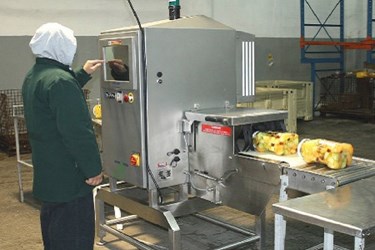4 Primary Technologies For Detecting Foreign Bodies In Food

By Sam Lewis

Despite the best efforts of every food and beverage processor, sometimes foreign material accidentally ends up in finished products. This can be due to a variety of reasons, such as equipment failure, employee carelessness, and even accidental input. Lucky for food makers, a wide array of foreign body detection solutions are available to help processors and packagers find unwelcomed substances.
Primarily, food and beverage processors and packers rely on four technologies to detect foreign bodies in food: metal detection, X-ray detection, visible/infrared (IR)/ hyperspectral imaging systems (camera/laser-based), and mechanical detection. Each of these methods and technologies come with their own strengths and weaknesses.
Video: Reducing Contamination Risks With Metal Detectors
Metal detection is adequate for finding metal contaminants in meat products. When using metal detection equipment in food processing, metal objects within a food product produce an unbalance in a balanced radio frequency or magnetic field. This generates an electrical signal alarming the equipment operator of the situation. This is useful for both ferrous (relation to iron) and non-ferrous metals inside a product and on its surface.
X-ray detection systems are able to find metal contaminants, as well as other solid contaminants with different densities than metal. The x-ray detection equipment produces an image of the food product that can be analyzed for contamination. This makes x-ray detection equipment useful for finding ferrous and non-ferrous metals, rocks, glass, bone fragments, and plastics with differing densities than the food product. These contaminants can be on the surface of the product or within the product.
White Paper: Reducing Plastics Contamination In Food Manufacturing
Camera and laser-based technologies identify differences in wavelengths of light reflected from foreign materials against the food product. This produces an image to be analyzed and is particularly useful for detecting foreign objects on the product’s surface. Finally, mechanical detection methods interact with the mechanical properties of the foreign body to separate it from the product. This is most useful for separating film, string, foam, plastic, and cloth from food.
Metal detectors, imaging systems, and x-ray technology seem to be the most effective in identifying contaminants in food. Metal detectors are a cost-effective solution for identifying metallic foreign materials, but since the systems only find metal, it is also a significant drawback.
Plastic contaminants present the most serious detection challenges as they are not found through metal detection the density of plastic is often similar to the product it is within, which makes detecting through x-ray inspection difficult. Most commonly found plastics in food are low-density polyethylene (LDPE) polyethylene (PE) films used in packaging and rubber/plastic gloves. Imaging systems are able to find plastics with contrasting color to food products, but colorless plastics are difficult to detect.
Food X-Ray Inspection Equipment: What You Should Know
There is no single solution to preventing foreign body contamination in food. The key to fixing contamination issues is to find the system(s) that best fit your operations needs and implement them as early as possible. Some processors may oppose implementing the correct types and number of detection systems in production facilities, but when it comes to protecting your products, your brand, and most importantly, your customers, penny pinching isn’t a great idea.
